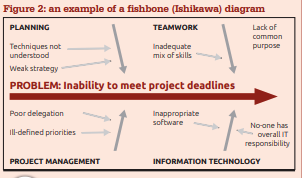The first and most important step in any project is defining its scope. What is it you are trying to achieve? Just as important is deciding what falls outside the scope of the project. Avoid the temptation to be too ambitious, as this can set you up for failure, whereas the sustained feeling of ongoing achievement that comes from breaking down complex tasks into smaller ones will keep you on track.
There are some key steps within scoping:
- Define your overall objective. Collect facts, opinions and needs; question assumptions and, if appropriate, perform an overall SWOT (strengths, weaknesses, opportunities, threats) analysis. Your objectives should meet SMART (specific, measurable, achievable, realistic and time-framed) criteria
- Determine your available resources. What people, facilities, finance and time do you have available to achieve the project objective?
- Establish a timeline. When does the project have to start by and when should it be completed? You may wish to allow for some contingency
- Put your project team together. Who do you need on the project if it’s to be a success? Get them together and start talking. They are the technical experts in any task, which is why you have them on your team. It is your job to manage them.
Fill in the blanks

There are some useful tools to draw on if you run an ideas session with your team to spark new thinking. Cause and effect diagrams, sometimes called fishbone or Ishikawa diagrams after inventor Professor Kaoru Ishikawa of Tokyo University (see Figure 2) are useful for brainstorming, exploring different perspectives and working out the factors that might otherwise be forgotten.
Through building a diagram with your team, everyone gains insight into the problem and can explore possible solutions. They will benefit too from sharing each other’s contributions, leading to a common understanding of the problem within the team.
Here’s how to create one:
- Identify the problem and write it down with an arrow underneath it. Think about the exact problem in detail. Where appropriate, identify who is involved, what the problem is, and when and where it occurs
- Identify the major factors and draw four or more branches off the large arrow to represent the main categories of potential causes. In a pharmacy, you might use ‘equipment’, ‘environment’, ‘procedures’, ‘people’. Make sure the categories you use are relevant to the particular problem
- Take each of the main categories and brainstorm possible causes of the problem
- Explore each one to identify specific ‘causes of causes’
- Continue branching off until every possible cause has been identified. Where a cause is complex, you might break it down into sub-causes. Show these as lines coming off each cause line
- Analyse your diagram. By this stage, it should show all the possible causes of a problem. Depending on the complexity and importance of the issue, you can now investigate the most likely causes further.
Most projects come in late (and are often over budget), so try not to be too strict in setting your timeline. Allow for some slippage, and err on the side of caution. Once you have done this, it is time to plan out the solution.
